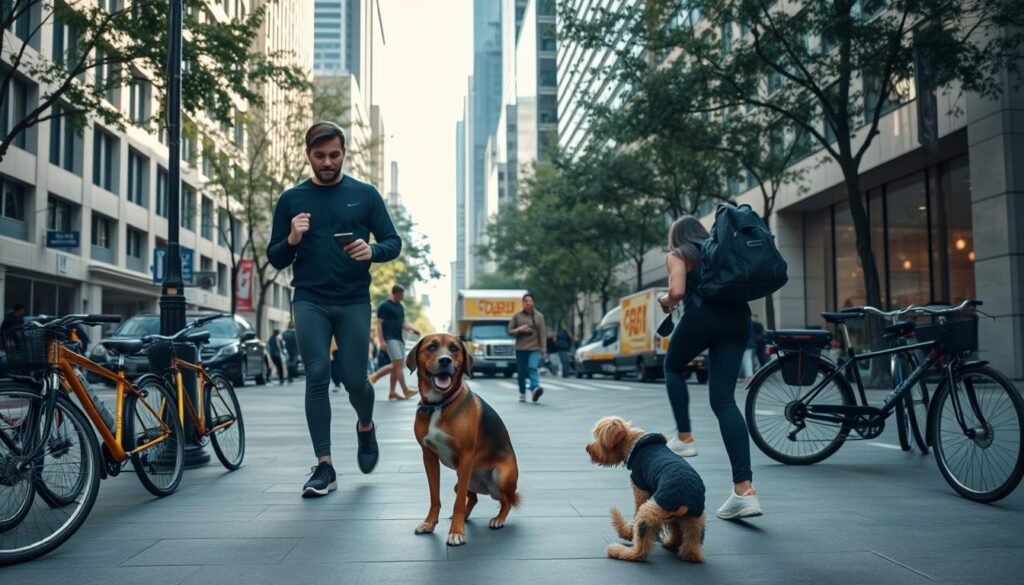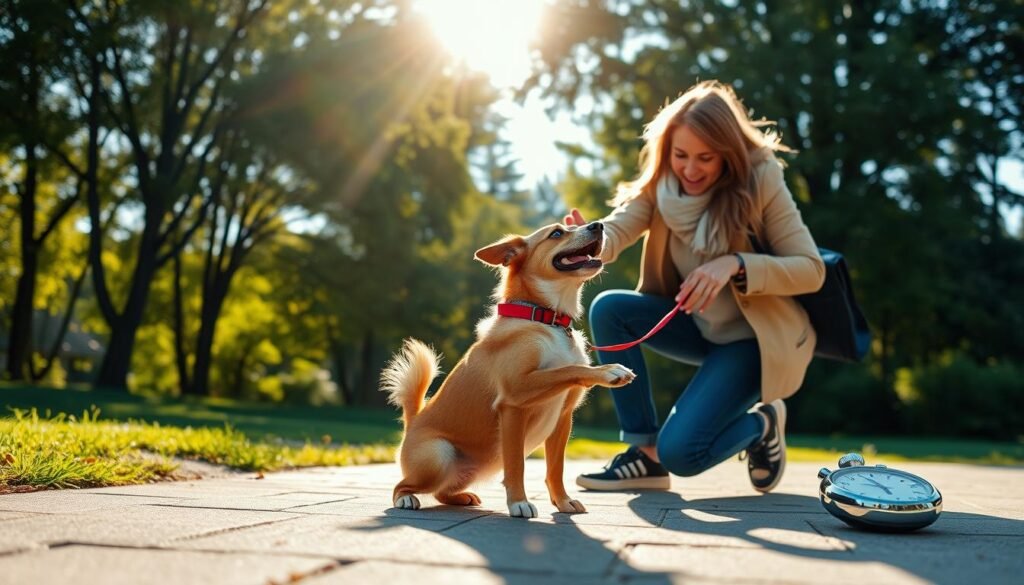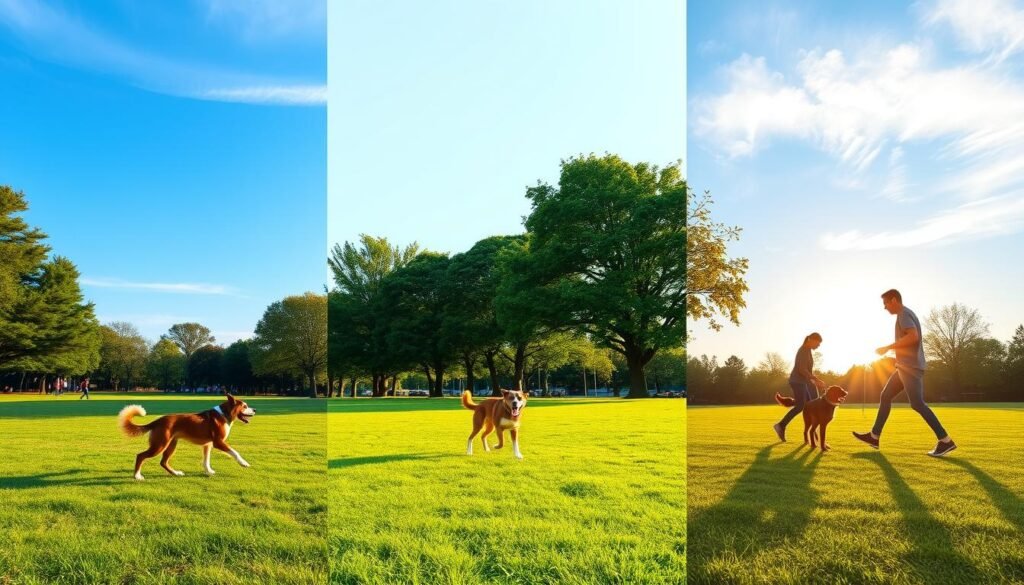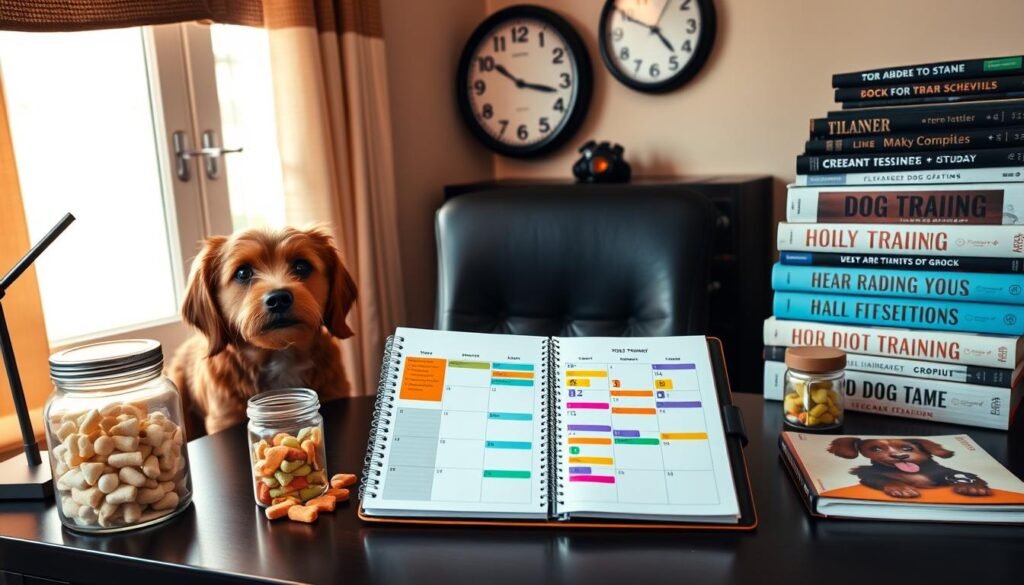Ever thought about training your dog when you’re always on the move? If work, family, and personal life fill your days, finding quick dog training can seem hard. But, what if short, focused sessions are enough for effective dog training?
In this article, we’ll look at quick training methods for busy owners. Learn how short, effective sessions can greatly improve your dog’s behavior. Forget the idea that hours are needed for results. It’s time for a more efficient dog training approach.
Quick Recommendation. Our blog is filled with tips and tricks for training your puppy or dog. If you’re seeking a comprehensive online training program, we recommend K9 Training Institute.
Understanding the Needs of Busy Dog Owners
As a busy dog owner, daily life often leaves little time for long training sessions. A hectic lifestyle can make it hard for your dog to learn new things. But, you don’t need to spend hours a day to see progress.
By using efficient training methods, you can fit in effective sessions with just a little time. Many experts suggest short, focused sessions throughout the day. This keeps your dog engaged and lets you fit training into your busy schedule easily.

Many dog owners have found success by training during daily activities. For instance, you can practice commands during meals, walks, or playtime. This not only makes training more efficient but also strengthens your bond with your dog.
Real-life stories from busy owners and advice from pet experts show that even a little time can make a big difference. By understanding and tackling the challenges of a busy schedule, you can still train your dog effectively. Whether you’re coming from a meeting or juggling chores, short but consistent training is possible.
Benefits of Quick Training Sessions
For busy dog owners, short training sessions are a game-changer. Research shows that brief, consistent training can greatly improve your dog’s behavior. The secret is using effective dog training strategies in these short sessions.
While long training sessions are common, they can be stressful. Short-duration dog training benefits both you and your pet. It makes training easier and less stressful.

Experts say dogs learn commands better in short, focused sessions. These brief sessions keep your dog’s attention, making training effective. This method proves that training doesn’t have to take a lot of time.
It fits into your busy schedule without feeling overwhelming. Sessions can be as short as five to ten minutes. Yet, they lead to significant improvements when done regularly.
This approach is a practical solution. It shows that effective dog training strategies can be manageable and quick.
Choosing the Right Time for Training
Choosing the best time for dog training is key for busy owners. Mornings are great because dogs are fresh and ready to learn. Try to fit training into your daily activities, like walks or playtime, for better results.

Evenings can also work well, especially after dinner when dogs are relaxed. By making training a part of your daily life, you keep a steady routine. This is important for your dog’s learning. Follow expert tips to schedule training during quiet times, keeping both you and your dog focused.
Setting Up a Training Schedule That Works
Creating a dog training schedule can seem hard, but it’s simple once you get it. It’s all about keeping it consistent. Whether you want to teach basic obedience or more, it’s key to fit it into your life and your dog’s needs.

Quick Recommendation. Our blog is filled with tips and tricks for training your puppy or dog. If you’re seeking a comprehensive online training program, we recommend K9 Training Institute.
Start by planning your week. Look for short times to train, even just 10-15 minutes a day. This can be a morning session before work and an evening one after dinner.
Set specific goals for each training session. For example, Monday for basic commands like “sit” and “stay.” Wednesday for leash training. This structure helps you make progress without feeling stressed.
Look at other successful training schedules for ideas. Many owners see big improvements by focusing on consistency. Keep an eye on your dog’s progress and tweak the routine as needed. This makes training fun and effective.
Also, add playtime to your schedule. It keeps your dog interested and helps reinforce good behavior. With a bit of planning and commitment, you and your dog will do great on a well-organized schedule.
Essential Training Techniques
Quick dog training methods start with the basics. Always use positive reinforcement. This means rewarding your dog with treats or praise for good behavior. It’s both effective and saves time.
Consistency is key in effective obedience training. Use the same commands and rewards every time. For example, always say “sit” for sitting and give a treat or praise.
Short, focused training sessions are also effective. Spend just five to ten minutes a couple of times a day on key commands. This works well for busy schedules, keeping training consistent without being overwhelming.
Make training fun by adding play. Use games like fetch to teach commands like “drop it” or “bring it.” This turns playtime into a productive training session.

Troubleshooting is crucial in effective obedience training. If your dog struggles with a command, break it down into smaller steps. Reward progress and be patient. With these methods, you’ll see improvements quickly.
Always end training sessions on a positive note. This keeps your dog excited for the next session. By using these essential techniques, even the busiest dog owner can achieve great results in no time.
Quick Training Sessions That Make a Difference
When you’re short on time, impactful dog training drills can be a game-changer. These methods work wonders, providing quick and effective results. They boost your dog’s behavior and discipline.
One prime example of a quick dog discipline method is the “sit and stay” drill. It encourages patience and obedience, vital for any well-behaved dog. Start by using treats as rewards, initially, and then gradually reduce their frequency as your dog gets the hang of it.
Moreover, the “touch” command is another impactful dog training drill. It’s simple yet highly effective in getting your dog to focus and follow instructions. This method not only improves concentration but also strengthens your bond.
Studies from sources like the American Kennel Club reveal that these quick training sessions can make a significant difference in just a few minutes each day. The consistency and repetition of these impactful dog training drills help embed these behaviors. This sets your dog up for long-term success.
Interactive Play as a Training Tool
Interactive play is a great way to make training fun for your dog. It keeps them entertained and helps with playful dog training. By making training a game, you and your dog stay interested and motivated.
Games like fetch or tug-of-war are excellent for training. They help teach commands like “sit,” “stay,” or “drop it.” These games make learning fun. Quick training sessions also keep your dog from getting bored or overwhelmed.
Using toys that give out treats can make training even more fun. For example, a treat-dispensing ball rewards your dog for following commands. This creates a positive link between training and rewards.
Changing up the interactive play keeps things exciting for your dog. Try agility courses or hide-and-seek games. These activities help teach obedience and discipline in a fun way.
Talking to professional dog trainers can help you make training sessions more engaging. They can suggest ways to match training to your dog’s needs and personality. This turns training into a fun, valuable part of your day.
Managing Behavioral Issues in Short Sessions
As a busy dog owner, you can still manage your pet’s behavioral issues effectively. Time-effective behavioral correction is key. Consistency is crucial, meaning you need to use quick behavior modification techniques regularly.
Experts say using short, focused sessions is best. For example, if your dog barks too much, a few minutes each day can help. These short efforts add up over time.
Studies show even short sessions can lead to big changes. A few minutes on leash training or positive behaviors like sitting can make a big difference. It’s all about consistent effort.
Tools and Equipment That Can Help
Having the right tools and equipment is key for dog training. There are many dog training aids that can make your training sessions better. They help your pup learn fast and well.
Clickers are a popular choice. They use positive reinforcement to teach your dog commands. The click sound and treats help your dog learn quickly.
Training collars are also crucial. Brands like PetSafe offer many types, from simple to advanced with remote controls. These collars help control your dog during walks and prevent pulling.
Interactive toys are great too. Toys like Kong and Tug-A-Jug keep your dog busy while teaching them patience and problem-solving. They’re perfect for rewarding good behavior.
Agility equipment turns your backyard into a training area. Items like hurdles, tunnels, and weave poles improve your dog’s coordination and obedience. They offer physical and mental exercise.
Using these dog training aids can make your sessions more effective and fun. They’re great for training puppies or improving adult dogs’ skills. The right tools can greatly improve your training success.
Incorporating Training into Everyday Activities
Making training a part of your daily routine can be easy and stress-free. Use everyday moments to teach your dog new things. For instance, ask your dog to sit before they get their food. This teaches them patience and rewards good behavior.
Household chores are also great for training. Practice commands like “stay” or “leave it” while you clean. This turns cleaning into a chance to teach your dog something new.
Even walks can be training sessions. Practice leash manners and recall commands during these times. Changing your walk route keeps your dog interested and helps them learn to obey better.
Playtime is also a great way to train your dog. Games like fetch or hide-and-seek can help them learn commands like “come” or “find it.” By using these methods, training becomes a natural part of your life, helping both you and your dog.
Conclusion
Adding successful dog training to your busy life can make your pet happier and more well-behaved. The tips shared here help you fit training into your schedule. They cover quick sessions, interactive play, managing bad behavior, and using tools.
Consistency is key. Mix training into your daily life. Pick the best time for training and be flexible. This way, your dog gets the help they need to do well.
Quick, focused training can be as good as long sessions. It helps your dog’s behavior improve. By balancing training with your daily life, you’ll strengthen your bond with your dog. You’ll also enjoy a more well-mannered pet.
Quick Recommendation. Our blog is filled with tips and tricks for training your puppy or dog. If you’re seeking a comprehensive online training program, we recommend K9 Training Institute.

